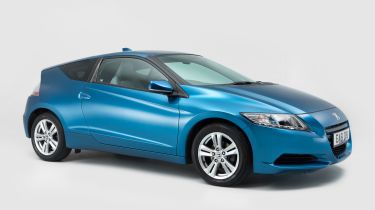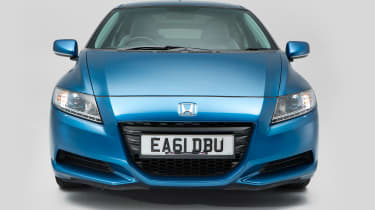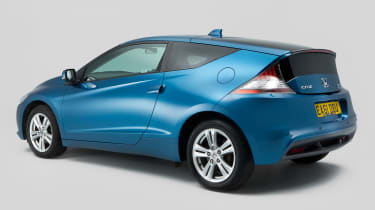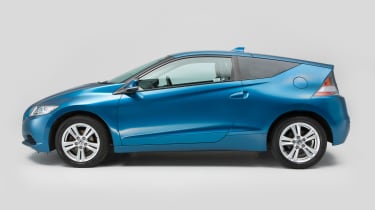Used Honda CR-Z review
A full used buyer’s guide on the Honda CR-Z covering the CR-z Mk1 (2010-2016)
Honda took a gamble with the CR-Z; it hoped to create a new sector and corner the market in hybrid sports cars. Sadly, this didn’t pay off, as the model’s lack of showroom sales success has proven. Don’t let this put you off, though, as the CR-Z offers something unique and it can make a very appealing used buy. You get that typical Honda reliability, a sporty drive, decent economy and a healthy dose of exclusivity. As these cars are usually kept by enthusiastic owners, most have covered low mileage and been cherished, which reduces the risk of buying a dud. If you’re after a future classic, look no further than this neat little eco coupe.
Sports cars are an indulgence, and hybrids are worthy machines designed to eke the most out of every gallon of fuel. The idea of combining the two might seem crazy, but that’s exactly what Honda did when it introduced the CR-Z.
Here was a green sports car that was fun to drive but still efficient. It put economy ahead of outright performance, while a racy experience and stylish coupe design meant limited practicality. The result was a model in a niche of its own, which meant in theory Honda had cornered the market – but sadly, it was a limited one. With fewer than 4,300 examples sold in the UK, the CR-Z is rare, yet it has more appeal than you might think.
Models covered
The Honda CR-Z first hit showrooms in 2010 and was on sale for six years before being discontinued in 2016. There was only one generation, and it’s this model that we’re focusing on here.
More reviews
Car group tests
In-depth reviews
Long-term tests
Road tests
- • Honda CR-Z Mk1 (2010-2016) - Eco coupe wasn’t a sales hit when new, but it’s a quirky and efficient used buy
Honda CR-Z
Prices from £5,000
History
The Honda CR-Z reached UK dealers in June 2010, with a choice of S, Sport or GT trim levels (priced at £17,000, £18,000 and £20,000 respectively). All cars came with a 112bhp 1.5-litre petrol engine that worked in tandem with a 14bhp electric motor. This also boosted peak torque by 77Nm to give 122bhp and 174Nm.
In November 2011 a Mugen-tuned CR-Z was unveiled, capable of 0-62mph in only 6.1 seconds; the standard car was pegged at 9.9-10.1 seconds, depending on trim. The newcomer was set to arrive in 2012, but instead it disappeared without trace. However, a facelifted CR-Z went on sale in January 2013, with a 119bhp engine, lithium-ion battery and extra colour options.
Honda CR-Z reviews
Honda CR-Z in-depth reviewHonda CR-Z reviewHonda CR-Z Sport reviewHonda CR-Z GT reviewHonda CR-Z Mugen reviewHonda CR-Z long-term test review
Which one should I buy?
Because all CR-Zs are virtually identical mechanically, it’s really simply a question of choosing which trim level suits you best. The later battery pack is worth having, though, as it’s more durable and efficient – meaning it can store more energy.
These later packs also cost more to replace, though, and few facelifted cars came to the UK. Of the 4,292 CR-Zs sold here, 3,777 were bought in the first three years.
S trim is rare; these cars have 16-inch alloys, climate control and ESP. Sport adds power-folding mirrors, rear parking sensors, a multifunction wheel, ambient lighting, privacy glass and a subwoofer. The GT gets Bluetooth, leather trim, heated front seats, automatic wipers and a glass roof.
Alternatives to the Honda CR-Z
The CR-Z has no rivals, as there are no other hybrid sports cars, but buyers may want to consider conventional petrol or diesel coupes and hatches. These include the Audi TT, VW Scirocco, Peugeot RCZ and Hyundai Veloster.
The Peugeot was offered with a choice of petrol or diesel engines, looked fabulous and had a surprisingly usable cabin, large boot and a good (rather than exciting) driving experience. The Audi is much the same but (at least as a coupe) offers hatchback practicality, much like the VW. That leaves the petrol-only Hyundai, which is another car that failed to make its mark in the UK. It’s intriguing, but worth a closer look only in Turbo form.
What to look for:
Economy
As with all hybrids, fuel efficiency varies massively according to driving style. Honda claimed 56mpg, but most owners get about 45mpg overall.
Tailgate
The tailgate can rattle because its upper edge makes contact with the bodywork. Sticking draft excluder along the edge quietens things down.
Rear seats
There are token back seats but they’re not much use, even for carrying children. It’s better to fold them down and use them for transporting luggage instead.
Visibility
Rear and rear three-quarter visibility aren’t great, but if you buy a Sport or GT model at least parking sensors will be fitted. S-spec cars didn’t get them.
Interior
Best viewed as a two-seater, the CR-Z has decent front head and legroom, with comfortable, supportive seats. Only small children will fit in the back. The boot is small, too, as it has to take the battery pack; there’s only 225 litres of space, or 401 litres if the back seats are folded.
Running costs
The CR-Z needs to be serviced every 12 months or 12,500 miles. Check-ups alternate between minor and major, and are generally priced at £155 and £255 respectively. As the CR-Z’s petrol engine is chain-driven there’s no timing belt to replace, but the brake fluid needs to be renewed every three years or 37,500 miles, at a cost of £50.
As well as this, the engine coolant should be replaced after 10 years or 125,000 miles, and then every five years or 62,500 miles. Expect to pay £65 to have the work done. You’ll pay the same amount to have the air-con serviced; there’s no set schedule for this, but once every two or three years is a good idea.
Recalls
A single recall isn’t a disaster for a car that came to market six years ago. It was issued in October 2011, and affected 3,045 CR-Zs built between December 2009 and June 2011. Potential software glitches with the electronic control unit (ECU) for the electric motor caused the recall.
As a result, the car could move back or forwards (depending on which gear was selected) if it were to stall. The fix was a simple software update, however, with no need for any new parts or hardware upgrades.
Driver Power owner satisfaction
Unsurprisingly, the CR-Z is too unusual to feature in Driver Power. However, four Hondas did appear in our 2016 survey: the Jazz Mk2 (112th), CR-V Mk3 (125th), CR-V Mk4 (57th) and Civic Mk9 (40th). The brand’s models tend to do well when quite new, but seem to drop down the rankings disappointingly quickly.









